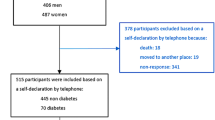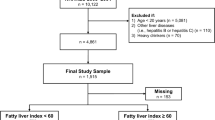Abstract
The increased prevalence of type 2 diabetes mellitus (T2DM) is associated with obesity, age, and sedentary lifestyle, but exposure to some organochlorine (OC) compounds has also been recently implicated. The hypothesis tested is that higher concentrations of bioaccumulative OC compounds are associated with T2DM. Plasma samples were obtained from a cross-section of adult male and female Caucasians and African Americans, either with or without T2DM from two US Air Force medical facilities. A method of extracting OC compounds from human plasma using solid phase extraction was developed, and three OC compounds [p,p’-DDE (DDE), trans-nonachlor, and oxychlordane] were quantified by gas chromatography/mass spectrometry. Multivariable logistic regression modeling indicated that increasing body mass index (BMI) was associated with T2DM in Caucasians but not in African Americans, and African Americans were more likely to have T2DM than Caucasians with decreasing odds ratios as BMI increased. An association between T2DM and increasing plasma DDE (adjusted for age, base, race, and BMI) was observed. Increasing DDE concentrations were associated with T2DM in older individuals and those with lower BMIs. Thus, in this study sample there was a higher risk of T2DM with increasing DDE concentrations in older people of normal weight and relatively lower risk associated with increasing DDE concentrations in those who are overweight or obese.
This is a preview of subscription content, access via your institution
Access options
Subscribe to this journal
Receive 6 print issues and online access
$259.00 per year
only $43.17 per issue
Buy this article
- Purchase on Springer Link
- Instant access to full article PDF
Prices may be subject to local taxes which are calculated during checkout
Similar content being viewed by others
References
Cowie CC, Rust KF, Ford ES, Eberhardt MS, Byrd-Holt DD, Li C et al. Full accounting of diabetes and pre-diabetes in the U.S. population in 1988-1994 and 2005-2006. Diabetes Care 2009: 32: 287–294.
Go AS, Mozaffarian D, Roger VL, Benjamin EJ, Berry JD, Borden WB et al. Heart disease and stroke statistics—2013 update: a report from the American Heart Association. Circulation 2013: 127: e6–e245.
CDC. Fourth national report on human exposure to environmental chemicals. Centers for Disease Control and Prevention. http://www.cdc.gov/exposurereport/pdf/fourthreport.pdf. 2009. Accessed November 20, 2013.
Adeghate E, Schattner P, Dunn E . An update on the etiology and epidemiology of diabetes mellitus. Ann NY Acad Sciences 2006; 1084: 1–29.
Ennaceur S, Gandoura N, Driss MR . Distribution of polychlorinated biphenyls and organochlorine pesticides in human breast milk from various locations in Tunisia: concentrations of contamination, influencing factors, and infant risk assessment. Environ Res 2008; 108: 86–93.
Bidleman TF, Leone AD . Soil–air exchange of organochlorine pesticides in the Southern United States. Environ Pollut 2003; 128: 49–57.
Jiang YF, Wang XT, Jia Y, Wang F, Wu MH, Sheng GY et al. Occurrence, distribution and possible sources of organochlorine pesticides in agricultural soil of Shanghai, China. J Hazard Mater 2009; 170: 989–997.
Rignell-Hydbom A, Rylander L, Hagmar L . Exposure to persistent organochlorine pollutants and type 2 diabetes mellitus. Hum Exp Toxicol 2007; 26: 447–452.
Ukropec J, Radikova Z, Huckova M, Koska J, Kocan A, Sebokova E et al. High prevalence of prediabetes and diabetes in a population exposed to high concentrations of an organochlorine cocktail. Diabetologia 2010; 53: 899–906.
Turyk M, Anderson H, Knobleloch L, Imm P, Persky V . Organochlorine exposure and incidence of diabetes in a cohort of Great Lakes sport fish consumers. Environ Health Perspect 2009; 117: 1076–1082.
Lee DH, Lee IK, Song K, Steffes M, Toscano W, Baker BA et al. A strong dose-response relation between serum concentrations of persistent organic pollutants and diabetes: results from the National Health and Examination Survey 1999-2002. Diabetes Care 2006; 29: 1638–1644.
Lee DH, Lee IK, Jin SH, Steffes M, Jacobs DR Jr . Association between serum concentrations of persistant organic pollutants and insulin resistance among nondiabetic adults: results from the National Health and Nutrition Examination Survey 1999-2002. Diabetes Care 2007; 30: 622–628.
Taylor KW, Novak RF, Anderson HA, Birnbaum LS, Blystone C, DeVito M et al. Evaluation of the association between persistent organic pollutants (POPs) and diabetes in epidemiological studies: a national toxicology program workshop review. Environ Health Perspect 2013; 121: 774–783.
Kim K-S, Lee Y-M, Kim SG, Lee I-K, Lee H-J, Kim J-H et al. Associations of organochlorine pesticides and polychlorinated biphenyls in visceral vs. subcutaneous adipose tissue with type 2 diabetes and insulin resistance. Chemosphere 2014; 94: 151–157.
Coombes RH, Crow JA, Dail MB, Chambers HW, Wills RW, Bertolet BD et al. Relationship of human paraoxonase-1 serum activity and genotype with atherosclerosis in individuals from the Deep South. Pharmacogenet Genomics 2011; 21: 867–875.
Barr JR, Maggio VL, Barr DB, Turner WE, Sjödin A, Sandau CD et al. New high-resolution mass spectrometric approach for the measurement of polychlorinated biphenyls and organochlorine pesticides in human serum. J Chromatogr B Analyt Technol Biomed Life Sci 2003; 794: 137–148.
Sandau CD, Sjödin A, Davis MD, Barr JR, Maggio VL, Waterman AL et al. Comprehensive solid-phase extraction method for persistent organic pollutants. Validation and application to the analysis of persistent chlorinated pesticides. Anal Chem 2003; 75: 71–77.
Schisterman EF, Whitcomb BW, Louis GM, Louis TA . Lipid adjustment in the analysis of environmental contaminants and human health risks. Environ Health Perspect 2005; 113: 853–857.
Phillips DL, Pirkle JL, Burse VW, Bernert JT Jr, Henderson LO, Needham LL . Chlorinated hydrocarbon levels in human serum: effects of fasting and feeding. Arch Environ Contam Toxicol 1989; 18: 495–500.
Bergonzi R, De Palma G, Tomasi C, Ricossa MC, Apostoli P . Evaluation of different methods to determine total serum lipids for normalization of circulating organochlorine compounds. Int Arch Occup Environ Health 2009; 82: 1241–1247.
Jakszyn P, Goñi F, Etxeandia A, Vives A, Millan E, López R et al. Serum concentrations of organochlorine pesticides in healthy adults from five regions of Spain. Chemosphere 2009; 76: 1518–1524.
Centers for Disease Control and Prevention. NHANES 2011/12 report http://www.n.cdc.gov/nchs/nhanes/search/nhanes11_12.aspx. Accessed 20 November 2013.
CDC/Diabetes Data & Trends. Centers for Disease Control and Prevention: National Diabetes Survelliance System. http://www.cdc.gov/diabetes/statistics. 2010. Accessed 20 November 2013.
Gasull M, Pumarega J, Téllez-Plaza M, Castell C, Tresserras R, Lee DH et al. Blood concentrations of persistent organic pollutants and prediabetes and diabetes in the general population of Catalonia. Environ Sci Technol 2012; 46: 7799–7810.
Arrebola JP, Pumarega J, Gasull M, Fernandez MF, Martin-Olmedo P, Molina-Molina JM et al. Adipose tissue concentrations of persistent organic pollutants and prevalence of type 2 diabetes in adults from Southern Spain. Environ Res 2013; 122: 31–37.
Airaksinen R, Rantakokko P, Eriksson JG, Blomstedt P, Kajantie E, Kiviranta H . Association between type 2 diabetes and exposure to persistent organic pollutants. Diabetes Care 2011; 34: 1972–1979.
Schmidt MI, Duncan BB, Bang H, Pankow JS, Ballantyne CM, Golden SH et al. Identifying individuals at high risk for diabetes: the Atherosclerosis Risk in Communities study. Diabetes Care 2005; 28: 2013–2018.
Stern MP, Williams K, Haffner SM . Identification of persons at high risk for type 2 diabetes mellitus: do we need the oral glucose tolerance test? Ann Intern Med 2002; 136: 575–581.
Wilson PW, Meigs JB, Sullivan L, Fox CS, Nathan DM, D’Agostino RB Sr . Prediction of incident diabetes mellitus in middle-aged adults: the Framingham Offspring Study. Arch Intern Med 2007; 167: 1068–1074.
Kerger BD, Scott PK, Pavuk M, Gough M, Paustenbach DJ . Re-analysis of Ranch Hand study supports reverse causation hypothesis between dioxin and diabetes. Crit Rev Toxicol 2012; 42 (8): 669–687.
Acknowledgements
We express appreciation to Dr. Matthew Ross, Dr. George Howell III, Lauren Mangum and MaryBeth Dail of Mississippi State University for their support in aspects of sample and data analysis and interpretation. We also thank Ashley Iovieno at Keesler Air Force Base and Tina Thomason at Wright-Patterson Air Force Base for their support in sample collection and transport. This work was supported by the Center for Environmental Health Sciences, College of Veterinary Medicine, Mississippi State University and Keesler Air Force Base. Samples and clinical information were provided by Keesler Air Force Base and Wright-Patterson Air Force Base. The views expressed in this material are those of the authors and do not reflect the official policy or position of the US Government, the Department of Defense, or the United States Air Force. The work herein was performed under United States Air Force Surgeon General approved Clinical Investigation No. FKE-20100017H, FKE-20100018E, and FWP-20100035H. The voluntary, fully informed consent of the subjects used in this research was obtained as required by 32 CFR 219 and AFI 40–402, Protection of Human Subjects in Biomedical and Behavioral Research. This is Center for Environmental Health Sciences publication 131.
Author information
Authors and Affiliations
Corresponding author
Ethics declarations
Competing interests
The authors declare no conflict of interest.
Rights and permissions
About this article
Cite this article
Eden, P., Meek, E., Wills, R. et al. Association of type 2 diabetes mellitus with plasma organochlorine compound concentrations. J Expo Sci Environ Epidemiol 26, 207–213 (2016). https://doi.org/10.1038/jes.2014.69
Received:
Accepted:
Published:
Issue Date:
DOI: https://doi.org/10.1038/jes.2014.69
Keywords
This article is cited by
-
Exposure to Endocrine-Disrupting Chemicals and Type 2 Diabetes Mellitus in Later Life
Exposure and Health (2023)
-
The association between environmental exposures to chlordanes, adiposity and diabetes-related features: a systematic review and meta-analysis
Scientific Reports (2021)
-
Persistent Organic Pollutants as Risk Factors for Obesity and Diabetes
Current Diabetes Reports (2017)



